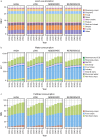Deployment expectations of multi-gigatonne scale carbon removal could have adverse impacts on Asia's energy-water-land nexus
- PMID: 39068194
- PMCID: PMC11283554
- DOI: 10.1038/s41467-024-50594-5
Deployment expectations of multi-gigatonne scale carbon removal could have adverse impacts on Asia's energy-water-land nexus
Abstract
Existing studies indicate that future global carbon dioxide (CO2) removal (CDR) efforts could largely be concentrated in Asia. However, there is limited understanding of how individual Asian countries and regions will respond to varying and uncertain scales of future CDR concerning their energy-land-water system. We address this gap by modeling various levels of CDR-reliant pathways under climate change ambitions in Asia. We find that high CDR reliance leads to residual fossil fuel and industry emissions of about 8 Gigatonnes CO2yr-1 (GtCO2yr-1) by 2050, compared to less than 1 GtCO2yr-1 under moderate-to-low CDR reliance. Moreover, expectations of multi-gigatonne CDR could delay the achievement of domestic net zero CO2 emissions for several Asian countries and regions, and lead to higher land allocation and fertilizer demand for bioenergy crop cultivation. Here, we show that Asian countries and regions should prioritize emission reduction strategies while capitalizing on the advantages of carbon removal when it is most viable.
© 2024. The Author(s).
Conflict of interest statement
The authors declare no competing interests.
Figures







References
-
- Lamboll, R. D. et al. Assessing the size and uncertainty of remaining carbon budgets. Nat. Clim. Change. 10.1038/s41558-023-01848-5 (2023).
-
- IPCC. Climate Change 2022: Mitigation of Climate Change. Contribution of Working Group III to the Sixth Assessment Report of the Intergovernmental Panel on Climate Change. (eds. P. R. Shukla, et al.) (Cambridge University Press, 2022).
-
- Smith, S. M. et al. The State of Carbon Dioxide Removal. 1st edn. (2023).
Grants and funding
LinkOut - more resources
Full Text Sources
Miscellaneous

